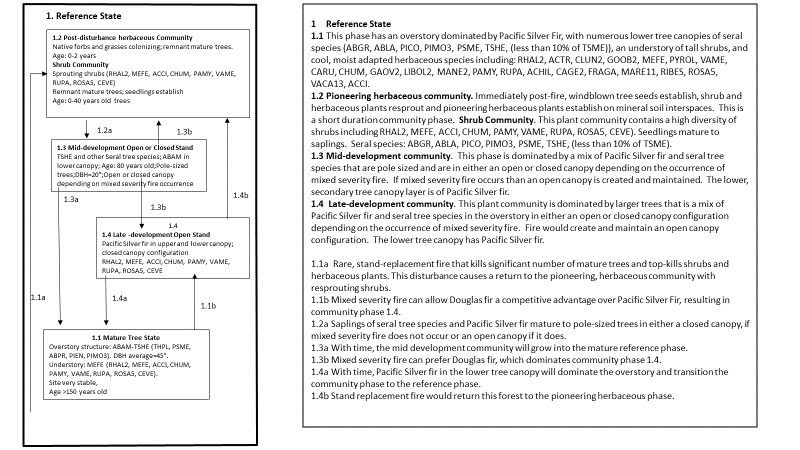
Natural Resources
Conservation Service
Ecological site F006XA006WA
Cold Cryic Udic Mountain Slopes (Pacific Silver fir Cold Moist Shrub/Herb)
Last updated: 2/14/2025
Accessed: 12/21/2025
General information
Provisional. A provisional ecological site description has undergone quality control and quality assurance review. It contains a working state and transition model and enough information to identify the ecological site.
MLRA notes
Major Land Resource Area (MLRA): 006X–Cascade Mountains, Eastern Slope
Major Land Resource Area (MLRA): 006X–Cascade Mountains, Eastern Slope.
Stretching from northern Washington to southern Oregon, MLRA 6 encompasses the mountain slopes, foothills, elevated plateaus and valleys on the eastern slopes of the Cascade mountains. This MLRA is a transitional area between the Cascade Mountains to the west and the lower lying Columbia Basalt Plateau to the east. Situated in the rain shadow of the Cascade Crest, this MLRA receives less precipitation than portions of the cascades further west and greater precipitation than the basalt plateaus to the east. Geologically, the majority of the MLRA is dominated by Miocene volcanic rocks, while the northern portion is dominated by Pre-Cretaceous metamorphic rocks and the southern portion is blanketed with a thick mantle of ash and pumice from Mount Mazama. The soils in the MLRA dominantly have a mesic, frigid, or cryic soil temperature regime, a xeric soil moisture regime, and mixed or glassy mineralogy. They generally are moderately deep to very deep, well drained, and loamy or ashy. Biologically, the MLRA is dominated by coniferous forest, large expanses of which are dominated by ponderosa pine, Douglas-fir or lodgepole pine. Areas experiencing cooler and moister conditions include grand fir, white fir, and western larch while the highest elevations include pacific silver fir, subalpine fir and whitebark pine. Economically, timber harvest and recreation are important land uses in these forests. Historically, many of these forests would have experienced relatively frequent, low and mixed severity fire favoring the development of mature forests dominated by ponderosa pine or Douglas-fir. In the southern pumice plateau forests, less frequent, higher severity fire was common and promoted the growth of large expanses of lodgepole pine forests.
LRU notes
This ecological site resides on mountain slopes in the mountains at elevations of 2900 to 4900 feet on slopes 8 to 60 percent. The climate is cool and moist with 35 to 100 frost free days, mean annual air temperatures average 37 to 42 degrees Fahrenheit, and the mean annual precipitation ranges 35 to 70 inches.
Classification relationships
The ecological site relates to the Wenatchee National Forest plant associations:
CFS556 - Pacific silver fir/Cascade azalea-big huckleberry (ABAM/RHAL-VAME)
CFF254 - Pacific silver fir/deerfoot vanillaleaf (ABAM/ACTR)
CFS542 - Pacific silver fir/rusty menziesia (ABAM/MEFE)
Ecological site concept
The soils are Andisols, specifically Humic or Xeric Vitricryands that have and ashy-skeletal or ashy-pumiceous particle-size class, and Spodosols, specifically Andic Humicryods that have medial-skeletal over loamy-skeletal class. The parent materials are volcanic ash mixed with colluvium or pumice. These soils are in the cryic soil temperature and udic soil moisture regimes. These are well drained soils with no flooding, ponding or water table.
The Reference Community has Abies amabilis in the overstory and lower canopy layers, though seral species may be present in low cover including: ABGR, ABLA, PICO, PIMO3, PSME, TSHE, TSME. The understory is diverse and can include: RHAL2, ACTR, CLUN2, GOOB2, MEFE, PYROL, VAME, CARU, CHUM, GAOV2, LIBOL2, MANE2, PAMY, RUPA, ACHIL, CAGE2, FRAGA, MARE11, RIBES, ROSA5, VACA13, VACCI. The ecological site relates to the USFS plant associations: Pacific silver fir/Cascade azalea-big huckleberry, Pacific silver fir/deerfoot vanillaleaf and Pacific silver fir/rusty menziesia.
Associated sites
| F006XA003WA |
Cryic Xeric Mountain Slopes (Subalpine fir Cool Moderately Dry Shrub/Herb) Slightly warmer and drier. |
|---|
Similar sites
| F006XB002WA |
Cold Cryic Udic Mountain Slopes (Mountain Hemlock Cold Moderately Moist Shrub/Herb) Higher elevations |
|---|
Table 1. Dominant plant species
| Tree |
(1) Abies amabilis |
|---|---|
| Shrub |
Not specified |
| Herbaceous |
Not specified |
Click on box and path labels to scroll to the respective text.
Ecosystem states
State 1 submodel, plant communities
| 1.1A | - | Rare, stand-replacement fire |
|---|---|---|
| 1.1B | - | Mixed severity fire |
| 1.2A | - | Saplings of seral tree species and Pacific silver fir mature to pole-sized trees in either a closed canopy, if mixed severity fire does not occur or an open canopy if it does. |
| 1.3A | - | Time |
| 1.3B | - | Mixed severity fire |
| 1.3C | - | Mixed severity fire |
| 1.4A | - | Stand replacement fire |
